
Thodore Herzl
What makes the study of Jewish carpets, the enquiry into their imagery and the search for understanding of the forces that came together to produce them, so rewarding? It is for me the insight it gives into some of the means behind the miracle of the survival of the Jewish people. In 1860 in France the Alliance Israelite Universale was formed. Its purpose was to work everywhere for the emancipation and moral progress of the Jews and to offer effective assistance to Jews suffering from anti-Semitism. Initially funded by Baron Maurice de Hirsch, hundreds of secondary, professional and craft-schools were established in France, its empire and in the Middle East. Over the years hundreds of thousands of young people were taken out of a life of poverty and into a life of productivity.
One such craft school was in Jerusalem where, under the leadership of Abraham Albert Antebi (1869-1918) these rugs, strictly speaking machine pile weaves, were made. In 1916, the Turkish military in command of Jerusalem accused Antebi of spying for the British. Exiled to Damascus, then drafted into the Turkish army, Antebi died of typhoid. Following General Allenby’s liberation of Jerusalem, the ORT school gathered up its people, equipment and material and carried on its work.
These rugs are important for they portray many of the idealized and pivotal figures in Zionism and fulfil the need to reflect them iconographically.
The textiles are made of chenille, a mercerized cotton that looks like silk, and, modelled on a classical Turkish prayer rug, share a strong red palette. The portraits, however, are transferred directly from photographs in much the same way that a television set digitally reproduces a picture, with the pixels in the T.V. screen corresponding to the knots in the rug. Too frangible for the floor, they were hung on walls or placed on tables and other surfaces.
In the first rug we see the best-known photograph of Theodore Herzl, the founder of modern Zionism. Here he is on a balcony in his hotel in Basel where, in 1897, he has gathered nearly 160 impecunious, mainly Russian and Polish Jews, for the First Zionist Conference. Herzl has insisted on (and paid for) many of them to wear formal black suits and white ties. They purport to speak for the millions of Jews all over the world but in fact have no backing from any of the major Jewish religious or civil bodies or from any of the Jewish magnates. Herzl’s “chutzpah” is almost unimaginable!
The designer of the rug has placed Herzl overseeing the ingathering of the exiles. Above them, against a rising sun implying the dawning of a new era, we see King David’s Tower in Jerusalem. This hugely successful rug was sold all over the world and would have been produced by the thousands. When the Israel Postal Authority sought a design for its stamp to celebrate the centenary of the First Zionist Conference, a picture of this rug was chosen.
The second weave, a double, portrays Max Nordau (1849-1923). In 1895 Herzl was in such a state of agitation that he was advised to see Max Nordau, an eminent Viennese psychiatrist and humanist philosopher. Nordau heard out Herzl’s fears and dreams and concluded the consultation by saying, “If you are insane, we are insane together. Count me in!” He and Herzl then jointly founded the World Zionist Organization, which held its first conference in 1897. It was Nordau who drafted the critical Basel program.
At the congress in 1911, he warned that if the current political trend persisted 6,000,000 Jews would be doomed to perish. In 1919, when a tidal wave of pogroms swept through the Ukraine and parts of Russia, he called for the speedy transfer of 600,000 Jews to Palestine within months. The Zionist leadership rejected his pleadings and later he retired from active Zionist work.
Nordau battled against philistinism and bigotry and contrasted the material poverty of the Jews of Eastern Europe with the moral and cultural poverty of the Jews of Western Europe. I do not think Nordau has been given the place in our history that his contribution deserved.
The third weave portrays Lord Balfour (1848-1930). A devout Christian, as British Foreign Secretary he sponsored and signed a momentous letter to Lord Rothschild expressing Britain’s sympathy with the establishment in Palestine of a national home for the Jewish people. He saw the Jewish homeland as an historic act of amends for a millennium and a half of persecution of the Jews by his co-religionists, stating that “the treatment of the race has been a disgrace to Christendom.” The motivation however, of most of the other members of the British cabinet was political expediency. Some thought that the Jews of America would lobby their government to help the British war effort, others that it might help keep the Russian Provisional Government (the Czar had just been overthrown) in the war. A few people in the cabinet thought it essential to pre-empt the Kaiser who, it was rumored, was about to make a similar declaration, and the majority welcomed the idea of splitting off Palestine from their enemy - Turkey, and adding it to the British Empire. Even Lawrence of Arabia, speaking from an Arab point of view, supported the case for a Jewish homeland.
Balfour’s Declaration of the 2nd November 1917 was a turning point in modern Jewish history.
The fourth weave portrays Chaim Weizmann (1874-1952).
First President of the State of Israel, he was perhaps the noblest figure in the creation of the State. Reader in biochemistry at Manchester University, he admired English culture at its best with its order, courtesy and sense of tolerance and fair play.
One particular difficulty that Britain faced at the outbreak of the First World War in 1914 was that although the war was to be fought primarily with explosives, the supply of raw material for acetone, an essential ingredient in their manufacture, was controlled by the enemy. Weizmann’s critically important invention of a new process of manufacturing acetone gave him access to the highest echelons of the British Government.
Among the many stories about the great man, my favorite is when, in 1906, he met Lord Balfour. Balfour asked why the Zionist organization had rejected Britain’s offer of a homeland in Uganda. Weizmann replied by asking Balfour if he would have abandoned London if he had been offered Paris. Balfour responded, “No, but London is the capital of my country,” to which Weizmann replied, “Jerusalem was the capital of our country when London was a marsh!” From that moment on Balfour was totally committed to the dream of Zionism. His charm, intelligence and mastery of three modes of thought, the Jewish, the English and the scientific – enabled him to make his uniquely important contribution to the creation of the State of Israel.
What is also interesting in these weaves is that the artist has united two elements that are usually considered incompatible: the formal/ideological and the emotive, the former being a visual representation of fundamental tenets of faith and ideology, the latter being the expression of the artist’s personal feelings through the use of asymmetrical line and non-naturalistic color. The emotive element is represented by the very warm dominant tones and lively oriental borders, while the formal/ideological element is represented both by the modern European near-photographic portraits of some of the major contributors to the creation of the State of Israel and by the formal architecture in the rug and its decorative symmetries. These two elements are also to be seen in their contrary use of space. The emotive, expressed through the Islamic abhorrence of space, fills every area with endless patterns; the formal utilizes pure space in the background to the portraits. The dynamic balance between opposites in these weaves in enhancing the central portraits of the founders of the State of Israel, reminds me how indebted we are to them all.
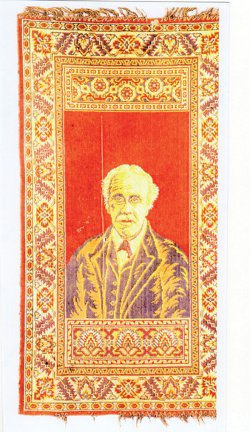
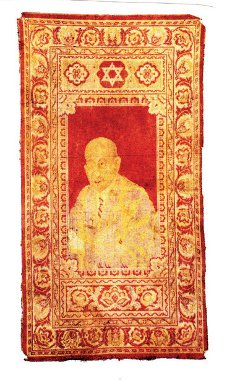
Lord Balfour Chaim Weizmann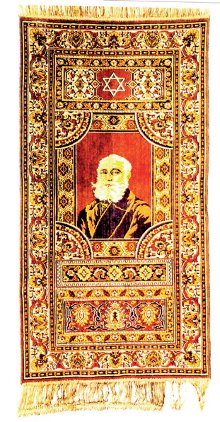
Max Nordau
© Anton Felton 2012
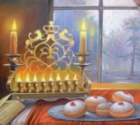 Chanukah 5773
Chanukah 5773 The Guild launches its season with The Fantasticks
The Guild launches its season with The Fantasticks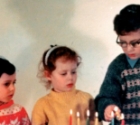 My Chanukiah
My Chanukiah Art from the Heart
Art from the Heart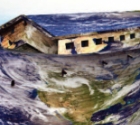 Jewish Art Returns to Jerusalem
Jewish Art Returns to Jerusalem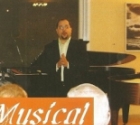 Musical Treats
Musical Treats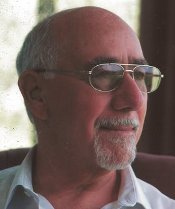 Anton Felton
Anton Felton